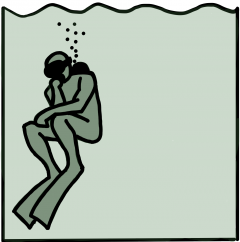I was thinking what might be a good measure for decompression quality or stress. This also comes as O’Dive with their end user Doppler Device claim to provide exactly that in their mobile phone application. As said before, I have some doubts about their approach, so let’s try to come up with something better.
As always here on TheTheoreticalDiver, everything is entirely theoretical, I have zero empirical data of my own. But with this disclaimer, here we go:
I think we all agree on the fact that decompression stress comes arises as tissue pressure exceeds ambient pressure and that also the time of this excess pressure is relevant.
But measuring the excess pressure in mbar is probably not very useful as this is not a natural measure of decompression stress (and the relation might as well depend on the tissue under consideration as well as ambient pressure and a million other things). The gradient factor approach is to normalise this excess pressure with the maximally allowed excess pressure (which is the definition of the gradient factor) and this sounds like a good start.
But rather than comparing to plain vanilla 100/100 Bühlmann, I would like to be more flexible and compare to your decompression model of choice. So I would like to take
\(q(t) := max\left(0, \frac{p_i(t) -p_{amb}(t)}{p_{i,max}(t) – p_{amb}(t)}\right)\)as a measure of momentary stress where p_i,max is the maximal allowed inert gas pressure in tissue number i as given by your decompression model.
This could be plain Bühlmann in which case this expression is just your momentary gradient factor. Or you believe in excess pressure being worse at depth (as the produced bubbles will grow later on in shallower water) then you take p_i,max as given by Bühlmann corrected by your favourite settings of GF_low and GF_high. Or you insist on using VPM-B then you use the maximal momentary M-value as predicted by that model. Strictly speaking this is an extension of that model for real (as opposed to planned) dives, but at least in Subsurface, we have found a way to compute it (such that it pretty much agrees on planned dives).
Obviously, if you decompress exactly as prescribed by you model, q=1 during decompression (possibly a bit lower due to the fact that most people decompress in steps of 10ft/3m rather than continuously). But
\(q\le 1\)is the definition of not violating the ceiling.
The ceiling being what it is, violating it should be bad and the more the worse whereas staying way below the ceiling gives your additional conservatism which you probably have to pay in terms of extended decompression time.
So, my proposal would be to compute the L^lambda norm of the function q(t) for somewhat large lambda as this punishes going above q=1:
\(\Big(\int q^\lambda dt\big)^{1/\lambda}=\Big(\int max\left(0, \frac{p_i(t) -p_{amb}(t)}{p_{i,max}(t) – p_{amb}(t)}\right)^\lambda dt\big)^{1/\lambda}\)To me, this seems to be a reasonable measure of deco stress. Maybe it’s worthwhile to compute this for a number of real profiles and compare it deco outcome (risk of DCS, I wish I had access to the DAN data… or at least Doppler results).
What do you think?


So what units do you use to measure decompression stress